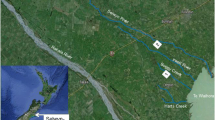Abstract
Surface waters (streams, rivers, and wetlands) are the most important groundwater dependent ecosystems (GDEs) in Otago, New Zealand. Pumping wells in the vicinity can deplete water in the GDE. In Otago, most of the surface water resources are allocated and a method, which would assist in the implementation of water management policy, is needed to acknowledge the strong hydraulic link between surface and shallow groundwater. A simplified method has been developed which derives a numerical relationship between the bore pumping rate and the distance between the bore and surface water body beyond which depletion is considered insignificant. A range of GDE depletion scenarios are examined at various combinations of hydraulic parameters to find a minimum distance for a given pumping rate, at which 90% of the modelled surface water depletion scenarios become less than a threshold GDE depletion after a specified time. A buffer zone, based on the minimum distance is placed around GDEs, and groundwater abstraction rights within the buffer are subject to stricter rules. Applicants wishing to abstract from bores within the buffer zone will need to address the environmental impact of the proposed activity on the GDE.
Résumén
Les eaux de surface (cours d’eau et zones humides) sont les plus importants écosystèmes dépendants des eaux souterraines (GDEs) in Otago en Nouvelle Zélande. Les puits de pompage les plus proches peuvent diminuer la quantité d’eau des GDEs. En Otago, la plus part des eaux de surface sont allouées et une méthode spécifique est nécessaire pour reconnaître le lien hydraulique fort entre eaux de surface et souterraine et appuyer une politique de gestion des eaux. Une méthode simplifiée a été développée, sous la forme d’une relation numérique entre le pompage d’un puits et la distance de ce puits à la zone humide, distance pour laquelle le prélèvement est considéré comme insignifiant. Plusieurs types de scénarios d’impacts sur les GDEs ont été examinés suivant différentes combinaisons de paramètres hydrauliques, conduisant à une distance minimum pour un débit de pompage donné pour lequel 90 % des eaux de surface modélisées subissent un épuisement seuil après un temps déterminé. Une zone tampon, basée sur la distance minimum est placée autour des GDEs, et le droit au prélèvement d’eau souterraine dans cette zone est sujet à des règles strictes. Les candidats au prélèvement dans la zone tampon devront définir les impacts de leur activité proposée sur les GDEs.
Resumen
Las aguas superficiales (ríos, arroyos, y humedales) son los ecosistemas dependientes de agua subterránea (GDEs) más importantes en Otago, Nueva Zelandia. El bombeo de pozos en la región puede agotar el agua en los GDEs. La mayor parte de los recursos hídricos superficiales en Otago ya están asignados y se necesita un método que permita reconocer el fuerte vínculo hidráulico entre el agua superficial y el agua subterránea somera y que pueda apoyar la implementación de una política de manejo hídrico. Se ha desarrollado un método simplificado que aporta una relación numérica entre el ritmo de bombeo en el pozo y la distancia entre el pozo y el cuerpo de agua superficial, más alla de la cual el agotamiento se considera insignificante. Se ha examinado un rango de escenarios de agotamiento de GDEs con varias combinaciones de parámetros hidráulicos para encontrar la distancia minima para una tasa de bombeo dada a la cual el 90% de los escenarios de agotamiento de agua superficial modelada llegan a ser menores a un valor normal de fondo de agotamiento GDE después de un tiempo especificado. Una zona de amortiguamiento basada en la distancia mínima se coloca alrededor de los GDEs y los derechos de explotación de aguas subterráneas dentro de la zona de amortiguamiento están sujetos a reglas estrictas. Los aplicantes que deseen extraer agua de pozos emplazados en la zona de amortiguamiento necesitarán elaborar el estudio de impacto ambiental de la actividad propuesta en el GDE.




Similar content being viewed by others
References
Bekesi G, Hodges S (2002) A statistical assessment of bore interference. NZ J Hydrol 41:47–52
Hunt B (1999) Unsteady stream depletion from ground water pumping. Ground Water 37:98–102
Hunt B (2005) Visual Basic programs for spreadsheet analysis: computer note. Ground Water 43:308–312
Hunt B, Weir J, Clausen B (2001) A stream depletion field experiment. Ground Water 39:283–289
Jenkins CT (1977) Computation of rate and volume of stream depletion by wells. In: Techniques of water resources investigations of the United States Geological Survey, Chapter D1, Book 4, 3rd edn., USGS, Reston, VA, 17 p
Kollet SJ, Zlotnik VA (2003) Stream depletion predictions using pumping test data from a heterogeneous stream-aquifer system (a case study from the Great Plains, USA). J Hydrol 281:96–114
SKM (2001) Environmental Water Requirements to Maintain Groundwater Dependent Ecosystems. Sinclair Knight Merz Pty. Ltd., Malvern, Australia
Sophocleous M (2001) Environmental implications of intensive groundwater use with special regard to streams and wetlands. In: Llamas R, Custodio E (ed) Intensive use of groundwater challenges and opportunities. Balkema, Lisse, The Netherlands
Sophocleous M (2002) Interactions between groundwater and surface water: the state of the science. Hydrogeol J 10:52–67
Sopocleous M, Koussis A, Martin JL, Perkins SP (1995) Evaluation of simplified stream-groundwater depletion models for water rights administration. Ground Water 33:579–588
URS (2000) Groundwater Dependent Ecosystems. Report Prepared for the South East Catchment Water Management Board. URS Australia Pty Ltd., Hackney, Australia
Author information
Authors and Affiliations
Corresponding author
Rights and permissions
About this article
Cite this article
Bekesi, G., Hodges, S. The protection of groundwater dependent ecosystems in Otago, New Zealand. Hydrogeol J 14, 1696–1701 (2006). https://doi.org/10.1007/s10040-006-0062-z
Received:
Accepted:
Published:
Issue Date:
DOI: https://doi.org/10.1007/s10040-006-0062-z




